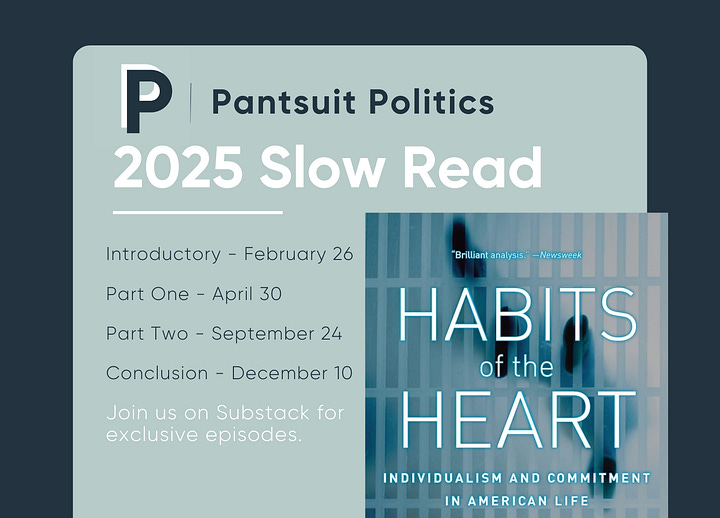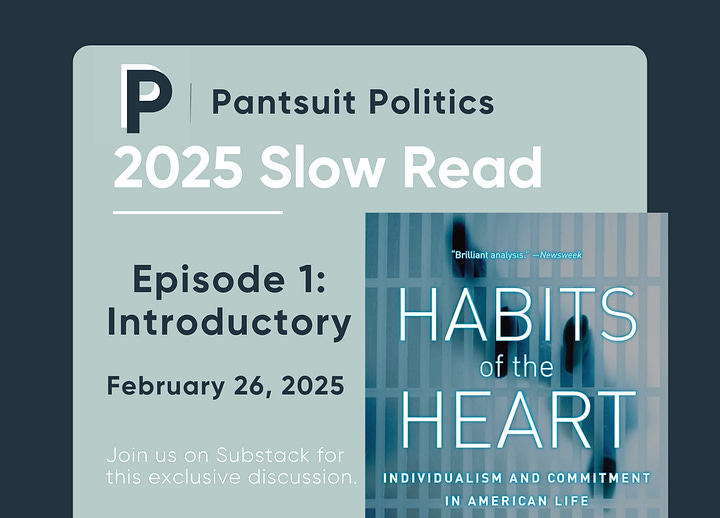Welcome to the Water Cooler
Hello and Welcome to 2025.
We are delighted to begin a new year with you. We know many of you are experiencing winter weather, and we hope you stay warm and safe.

If you’d like something cozy to listen to while you wait for today’s new episode to publish, you may have missed Sarah and Beth’s new episode from last Friday with Anna Goldfarb about her book Modern Friendship (be sure to pull out your tissues when Anna tells the story of her father’s friendship with Marty).
We’ll be in your podcast feeds later this afternoon with Sarah and Beth catching up on the news from over the holidays including President Jimmy Carter’s life, the domestic terror attacks, and, of course, what is on our minds outside of politics.
We are committed to taking each day as it comes in this new year and are so grateful that all of you are in it with us.
Pantsuit Politics Bulletin Board
Reminder: We’re continuing to beta test our Monday, Wednesday, and Thursday premium schedule through January 20. Our Tuesday episode of Pantsuit Politics will be in your feeds later this afternoon.
More to Say: Beth started us off this week considering the 4-day School Week
Good Morning: Yesterday, on the Good Morning News Brief, Sarah got us started with an update on the 119th Congress. She’ll be back tomorrow with our next update.
2025 Slow Read: Habits of the Heart
Over our holiday break, Sarah and Beth shared our final conversation about our 2024 Slow Read Democracy in America and their thoughts on the state of Democracy in America as we head into 2025.
We’re following up on Democracy in America with our 2025 Slow Read: Habits of the Heart about the struggle between individualism and community in American life. Get your copy wherever you get books and we’ll be sharing our first conversation on Part 1 at the end of February.


From the Spice Cabinet
Whenever the subject of RFK Jr and the growing popularity of many of his views on vaccines or fluoridated water comes up, the public health experts in the Spice Cabinet always have insights and context for “why we do things this way” that we want to put on a billboard.
Our listener, Anna, is a dentist and mentioned in a comment that fluoridated water for dental (and overall) health is a modern miracle of public health. She generously expanded to share the story of fluoridated water with all of us:
Despite what you may have heard, fluoride occurs naturally in all drinking water. Even if it’s not treated by the local community, it’s the 13th most abundant element in the Earth’s crust. So why do we add it to our water?
In 1901, a young dentist named Dr. Frederick McKay moved from the East Coast to Colorado Springs to open a dental practice. When he arrived, he found several kids had brown stained teeth. These kids were all born and raised in the community. Eventually, he noticed that these brown-stained teeth didn’t have cavities like other teeth.
Dr. McKay started investigating the cause of the brown stains. His first big breakthrough came when a town in Idaho started experiencing the same thing when they switched water supplies.
Dr. McKay journeyed to Oakley, Idaho to test the new water supply. But when he tested the water, he didn’t find anything unusual. Still, he advised the town to switch to a different water supply. They did. A few years later, all newly erupted teeth no longer had brown stains.
A few years later, Dr. McKay teamed up with Dr. Grover Kempf of the US Public Health Service to investigate another town with brown-stained teeth. This town was Bauxite, Arkansas. A well-water town. Again, they couldn’t find anything specific in the water, but a riverwater town 5 miles away had no brown stains.
Bauxite was different from the other towns. It was a company town owned by the Aluminum Company of America (ALCOA). And ALCOA was already dealing with claims that aluminum cookware was poisonous. When Dr. McKay published a report about the brown stains showing up in Bauxite, the company was motivated to prove it wasn’t because of them.
H. V. Churchill, ALCOA's chief chemist, had access to more sensitive technology. He tested the water of Bauxite, Colorado Springs, and the abandoned well in Oakley. All three water samples had an unusually higher-than-average amount of fluoride in the water. In Bauxite, it was 13.2 parts per million (ppm). Surface water, like lakes and rivers, usually has 0.1-0.2 ppm.
From this, Dr. H. Trendley Dean, of the National Institute of Health (NIH), researched how high can fluoride levels be before they cause discoloration in teeth. For most people, that’s 1.0 ppm.
He next tested if fluoride at this lower amount could still help prevent tooth decay without the unsightly brown stains. In 1945, Grand Rapids, Michigan, became the first city in the world to fluoridate its drinking water. 11 years after the addition of fluoride to its water, tooth decay among Grand Rapids children born after the start of fluoridated water dropped more than 60 percent.
From this, other cities with naturally low fluoride levels in their drinking water began to supplement it. We put fluoride in toothpaste and mouth rinses. We discovered exposing fully erupted teeth to fluoride can make them slightly stronger, too. making it harder for those teeth to get cavities.
Fast forward to today: several dental filling materials release fluoride directly into the tooth. We use these new materials to prevent future decay while also remineralizing the broken-down tooth. But I would argue nothing has helped prevent tooth decay than adding fluoride to our drinking water.
Copyright (C) 2024 Pantsuit Politics. All rights reserved.





Anna, thanks for sharing the history of fluoridation. I especially enjoyed reading how people from different towns joined forces to solve the mystery. Sometimes it takes someone from outside a group/community to recognize an ‘it’s always been like that’ may not be the way it has to be.
Loved the short history on fluoridation. Thanks!